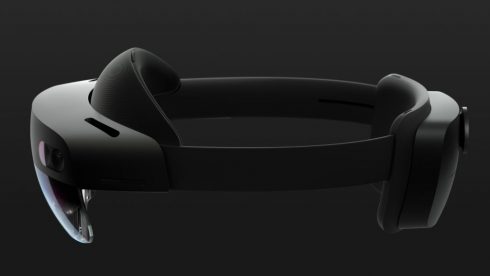
MWC Barcelona, formerly known as Mobile World Congress, is in full swing this week with new innovations and announcements for the mobile space.
Microsoft used the event to showcase its latest mixed reality device. The Microsoft HoloLens 2 has been improved for immersion, comfort and time-to-value. “We are entering a new era of computing, one in which the digital world goes beyond two-dimensional screens and enters the three-dimensional world. This new collaborative computing era will empower us all to achieve more, break boundaries and work together with greater ease and immediacy in 3D,” Julia White, corporate vice president for Microsoft Azure, wrote in a post.
For immersion, the company has worked to advance the visual display system for a more vibrant and realistic feel, and has more than doubled the field of view. For comfort, the HoloLens 2 features a light carbon-fiber material and new mechanism for re-adjusting. In addition, a new partner ecosystem is accelerating time-to-value.
Microsoft has also announced its mixed reality ecosystem will take an open approach — meaning it will embrace open stores, open browsers and open developer platforms. As part of this announcement, Mozilla has revealed Firefox Reality will be coming to the device. “Our Mixed Reality program at Mozilla is focused on bringing the best browsers, services, and tools for developers to ensure that users have a safe, private experience with open, accessible technology. Alongside our desktop and standalone VR browser efforts, this prototype of Firefox Reality for HoloLens 2 will ensure that the immersive web works for all users, regardless of device they are on,” Mozilla’s director of engineering for mix reality Lars Bergstrom, wrote in a post.
Mozilla will work with the Rust programming team to make this a reality and provide a runtime capable of delivering a secure experience.
Other announcements from the conference included:
Qualcomm’s Robotics RB3 Platform
Qualcomm introduced the company’s first platform focused solely on the robotics industry. The Qualcomm Robotics RB3 is designed for manufacturers as well as developers building the next generation of consumer, enterprise and industrial robots.
“With the Qualcomm Robotics RB3 Platform, we aim to bring our cutting-edge AI, edge compute and connectivity technologies into the hands of many more robotics innovators to help spur the fast development and commercialization of a new generation of useful and intelligent robots in agriculture, consumer, delivery, inspection, service, smart manufacturing/Industry 4.0, warehousing and logistics, and other applications,” said Dev Singh, director of business development and head of autonomous robotics, drones and intelligent machines and Qualcomm.
The platform features development board offerings for prototyping, system-on-module solutions, chip-on-board designs, and support for Linux and ROS. Other technical features include a heterogeneous computing architecture, Qualcomm AI engine, camera and view, advanced security capabilities, sensor and microphone support and connectivity support.
McAfee find new IoT vulnerabilities
McAfee researchers uncovered two new vulnerabilities creating risks for connected devices. According to the researchers, these bugs could give hackers access into consumer’s personal lives. The vulnerabilities included one in the BoxLock smart padlock, which could enable hackers to unlock the device within seconds; and one in the Mr. Coffee brand coffee maker that could give hackers access to home networks.
“Cybercriminals are relentless, and as long as we continue to connect devices to the internet, they will continue to search for ways to exploit them,” said Raj Samani, McAfee fellow and chief scientist. “Vulnerability disclosures can be frightening for both the consumers using connected devices and the organizations that create them, however, the process is an essential component of creating a safer future. Cybersecurity researchers, businesses, and consumers working together to expose and eliminate these vulnerabilities keeps us all a step ahead of the bad guys.”
Additionally, the company unveiled its Mobile Threat Report, which found a 550 percent increase in consumer security risks when it comes to fake and malicious apps. More information is available here.
Afilias tackles counterfeit mobile devices
Afilias announced a new solution designed to address problems caused by counterfeit devices. DeviceAssure aims to give financial services providers, enterprise security organizations, government agencies, and app-enabled service provides the tools to determine the authenticity of a mobile device. According to the company, counterfeit devices are often associated with cyber crimes such as malware, ransomware, keylogging and data theft.
SAP Leonardo IoT introduced
SAP introduced a new Internet of Things solution targeted at digital transformation for Industrial IoT and Industry 4.0. According to the company, SAP Leonardo will help bring IoT data together with business processes to increase productivity, redefine customer experience and grow revenue streams. In addition, it will enable IoT in line-of-business solutions.
“With the launch of SAP Leonardo IoT, SAP solidifies its commitment to the IoT, and in particular Industrial IoT. The combination of IoT and our depth and breadth of high-value industry and application expertise helps customers gain greater business value and a stronger competitive advantage,” said Elvira Wallis, senior vice president and global head of IoT at SAP.
SAP will offer three paths to IoT innovation: combining IoT data for IoT-embedded business apps, extending existing SAP IoT apps, and building new intelligent IoT solutions.






